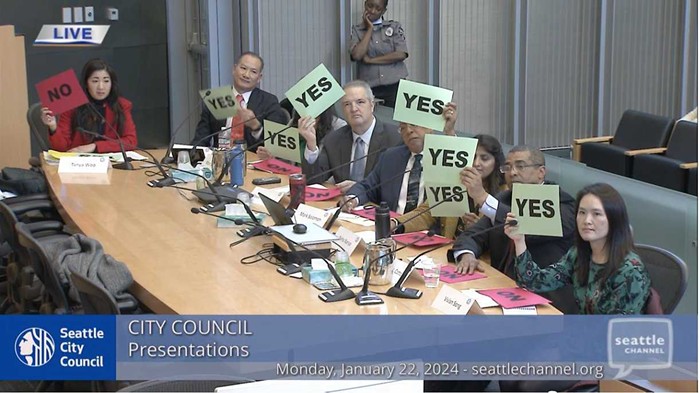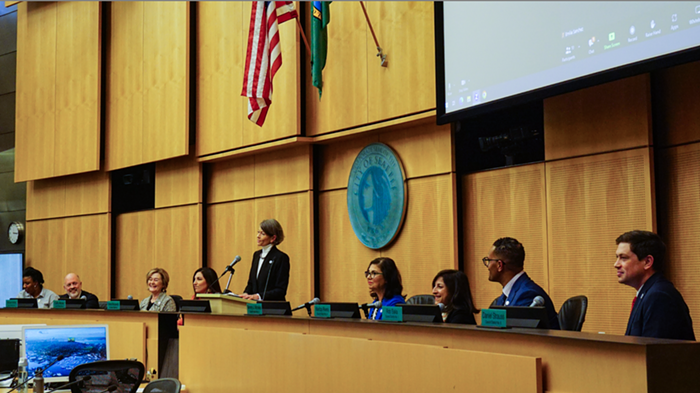Given all this, King County Prosecutor Steve Hobbs was floored by the judge's sentencing decision last week. Hobbs had asked that the youth be put away until he was 18 years old. Juvenile Court Judge Jim Street, however, sided with defense attorney Anne Kysar, who asked that the boy be given a less-than-standard sentence: one year at the detention center and two years of community supervision.
What went wrong for the prosecutor? During last week's sentencing hearing, Hobbs had tried to portray the case in black-and-white terms, a standard prosecutor approach. For Hobbs, any decision that would lighten the sentence for the boy would mean a threat to society. A tough sentence would show other youths that this kind of behavior will not be tolerated.
Judge Street, however, looked at the boy and the juvenile criminal justice system through a more complicated lens than the prosecutor. While Hobbs was going on about "future dangerousness," Street was looking for the best way that the justice system could serve both the boy's needs and the community's needs. In turn, at the heart of the judge's ruling was the implicit allegation that King County's juvenile detention center is not the best place for the Skyway boy--an implicit indictment of our juvenile justice system.
Juvenile detention facilities were originally created to serve as places of rehabilitation. Judge Street, however, implied in his ruling that the only difference between King County's detention center and the county's adult prison system is that juvenile detention has more inmates who are still growing out their wisdom teeth.
Street never came out and directly said that he had no faith in juvenile detention, but he might as well have. Although two Dimmitt teachers and the Dimmitt principal had asked that the youth be locked up for years, Street declared that this would be "self-defeating." "We need accountability," Street said, "but not at the expense of treatment." The judge noted that he felt comfortable giving the youth time in detention because the teen had already demonstrated a "resilience" to life in the detention center. Street's phrasing begs the question of how resilient one has to be to survive juvenile detention.
With time already served, the boy would only be spending 46 weeks in detention, but it was important that the youth spend the time contemplating what he had done. "[The youth needs] some time in a secure facility as punishment," Street acknowledged. But the judge backed his relatively lenient sentence with carefully itemized points. First, the 13-year-old had no prior criminal record. Second, the psychological assessments of the youth all indicated that he had simply acted out a childhood fantasy with an adult weapon. Third, county social workers had testified that they would be able to fashion a psychological treatment plan for the boy--if he wasn't locked up for too long. Citing this, Street said that "more time in [the detention center] would result in less effective rehabilitation."
Why did Street rule as he did? First, Street's a liberal judge loved by public defenders. A former Seattle City Council member, Street plans on retiring in January after only four years on the bench. After he's out of the courts, he told The Stranger that he may volunteer with at-risk youths. Second, defense attorney Kysar used a very effective tactic when she provided counsel for the youth: She put the juvenile detention center on trial.
To do this, she started by establishing that the teen needed treatment. Kysar used Dr. Marty Beyer, a criminal psychologist who spent eight hours assessing the youth's mental and emotional condition. Beyer noted that the boy had written numerous suicide notes in the preceding months, though no one paid attention. Everything the youth was doing, the psychologist said, was part of an effort to get attention.
Next, Kysar brought her argument to its depressing conclusion, throwing the spotlight on the detention center itself. Based on Beyer's testimony, Kysar argued that the youth would be developmentally ruined by the detention system if he were forced to spend the rest of his teenage years there. Beyer told the court that a lengthy detention sentence would have a potentially devastating effect. "Being around delinquent peers increases delinquent behavior," the psychologist told Street. "It could be harmful and dangerous [for the youth] to be placed in an environment that didn't treat depression."
And Kysar's case was unexpectedly supported by the abrupt appearance of a surprise witness. Shortly after Beyer spoke, Elizabeth Stall, a youth minister, demanded to speak before the court. Though highly unorthodox, Judge Street allowed the testimony, illustrating that juvenile court proceedings can be far more informal than an adult trial.
Stall told the court that she was worried for the boy. The detention center, she said, is no place for a minor struggling with depression. "Shame is often used as a treatment," Stall told the judge. At juvenile detention, Stall said, staffers often and arbitrarily hold youths up for ridicule--a bizarre, counter-productive punitive practice.
Hobbs' courtroom performance had compelling elements for the mainstream media, but it ultimately failed, because it didn't rebut Kysar's argument that the juvenile detention center wasn't working. Hobbs' ploy was to show that the boy was dangerous. Elaine Evans, a probation counselor, took Hobbs' side by painting the 13-year-old as a calculated manipulator who may be capable of killing again. "He could've gotten rid of the gun but refused to do so," Evans said. She noted that the youth was "reading at a college level," was "attractive and popular with girls," and could "make friends easily." With a sinister note, she added that the 13-year-old could "even discuss Vivaldi the composer." The point may have been lost on Street, particularly because Evans did not explain how the youth's knowledge of an early 18th-century Baroque composer could have affected the boy's ability to make moral choices.
None of this effectively countered the evidence Kysar had mounted. Teacher Jennifer Pierce-Malave was an instant media darling during the sentencing hearing because she gave a teary-eyed account of how she feared for her life when the youth shot out the cafeteria ceiling. But Pierce-Malave undermined her own credibility by basically admitting that she had fled the cafeteria before she was sure that all the children had escaped. Pierce-Malave's colleague, Robert Olson Brown, was more compelling, though he essentially said the same thing: The armed kid scared him on that fateful July day.
Hobbs didn't refute Kysar's successful legal strategy because, like the media, he didn't anticipate an outright attack on the system itself. "We didn't know that the defense was going to make that argument [against the detention center]," he admitted a day later. Hobbs, who strongly disagrees with Judge Street's analysis, may appeal the decision.

















